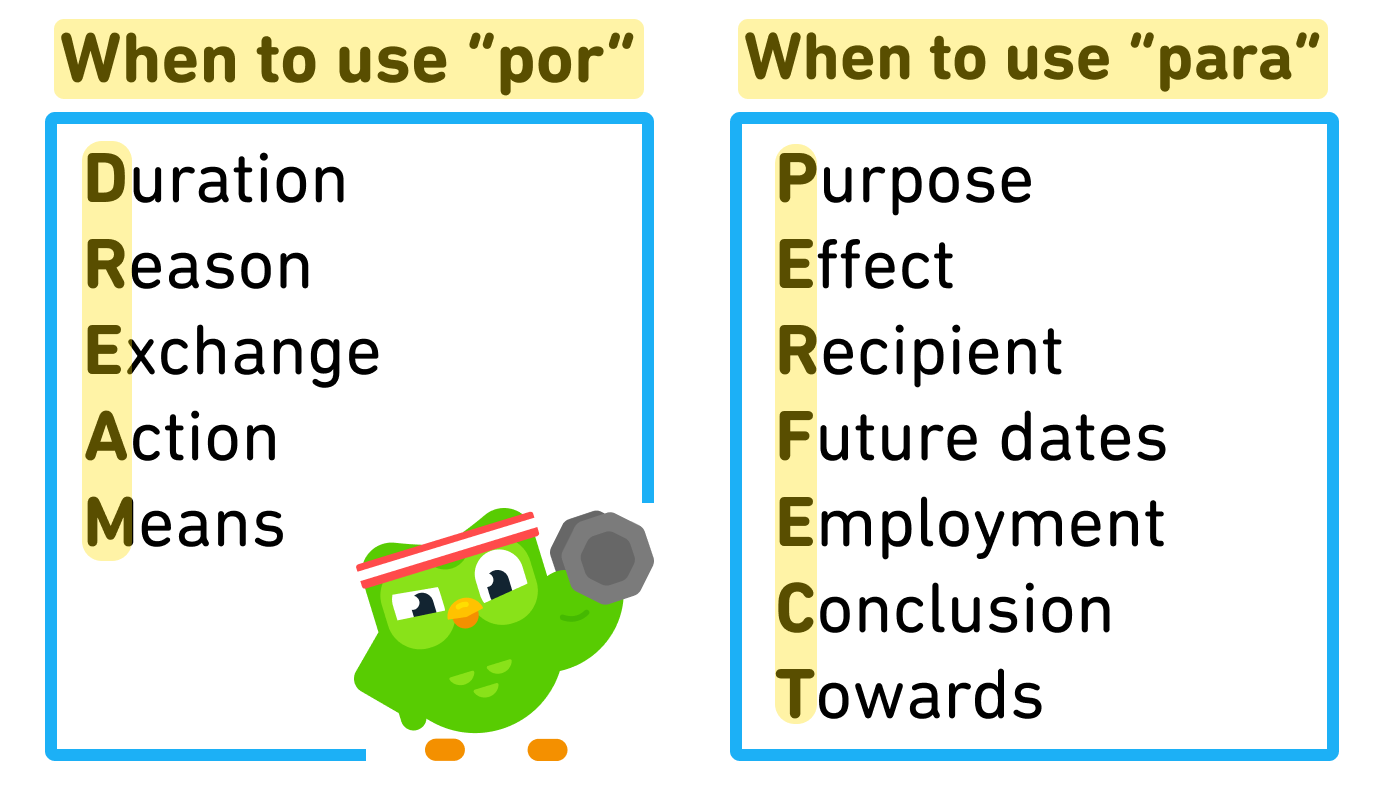Mastering 'Por Qué': The Four Forms Of Spanish 'Why' & 'Because'
Table of Contents
- The Perplexing 'Por Qué' Family: An Overview
- Unpacking 'Por qué': The Interrogative and Exclamatory Power
- Understanding 'Porque': The Causal Conjunction
- Differentiating 'Porqué': The Noun of Reason
- Clarifying 'Por que': The Preposition and Relative Pronoun
- Pronunciation vs. Spelling: Why They Sound Alike
- Mastering the Nuances: Tips for Avoiding Common Mistakes
- Beyond the Basics: The Importance of Orthography in Spanish
The Perplexing 'Por Qué' Family: An Overview
One of the most common sources of confusion in the Spanish language revolves around the distinction between "porque," "porqué," "por qué," and "por que." As the Real Academia Española (RAE) meticulously explains on its website, these four forms, despite their visual and phonetic similarities, serve vastly different grammatical roles. They can function as a conjunction, a preposition, an interrogative, an exclamatory, or even a noun. The fundamental challenge lies in the fact that, for native speakers and learners alike, they are basically pronounced the same way. This phonetic identity is precisely why there's a strong tendency to confuse them in writing, even though they are distinct entities with unique meanings and applications. Mastering the nuances of each form is paramount for achieving grammatical precision and clarity in your written Spanish. It's not just about memorizing rules; it's about understanding the underlying logic that dictates their usage.Unpacking 'Por qué': The Interrogative and Exclamatory Power
The form "por qué" is perhaps the most recognizable of the quartet, primarily because it's used to ask "why." It is formed by the preposition "por" and the interrogative or exclamatory pronoun "qué." The key distinguishing feature here is the accent mark (tilde diacrítica) on "qué," which makes it a tonic word, differentiating it from the relative pronoun or conjunction "que." This accent is crucial because it signals that "qué" is carrying an interrogative or exclamatory weight, demanding an answer or expressing strong emotion. When you see "por qué," you should immediately think of a question or an exclamation, whether direct or indirect. This form cannot be substituted by terms like "reason," "cause," or "motive," unlike the noun "porqué."Direct Questions with 'Por qué'
In direct questions, "por qué" always appears at the beginning of the interrogative clause, often followed by a question mark. It directly seeks the reason for something. This is its most straightforward and common application. * **Example:** `¿Por qué no viniste ayer a la fiesta?` (Why didn't you come to the party yesterday?) * Here, the speaker is directly asking for the reason behind the absence. The "qué" is stressed, indicating its interrogative nature.Indirect Questions and Exclamations with 'Por qué'
"Por qué" also introduces indirect interrogative and exclamatory sentences. In these cases, the question or exclamation is embedded within another sentence, so no question mark or exclamation mark is used at the end of the full sentence, but the "qué" still retains its accent because it's still interrogative or exclamatory. * **Example (Indirect Interrogative):** `No comprendo por qué te pones así.` (I don't understand why you get like that.) * This is an indirect question. The speaker isn't asking a direct question but expressing a lack of understanding about the reason. The "qué" remains stressed, justifying its accent mark. We can recognize this as an indirect interrogative because we could form the corresponding direct interrogative: `¿Por qué te pones así?` * **Example (Indirect Interrogative):** `No sabía por qué solución decantarse.` (I didn't know which solution to choose.) * Again, an indirect question embedded in a statement. * **Example (Exclamatory):** `¡Por qué calles más bonitas pasamos!` (What beautiful streets we passed through!) * Here, "por qué" introduces an exclamation, expressing surprise or admiration about the streets. * **Example (Exclamatory):** `¡Por qué cascadas más hermosas pasó la lancha!` (What beautiful waterfalls the skiff passed through!) * This similarly conveys an exclamatory sentiment about the beauty of the waterfalls. In all these instances, the "qué" is tonic, meaning it carries the stress, which is why it always takes the diacritical tilde. This distinguishes it from the unstressed "que" found in other contexts.Understanding 'Porque': The Causal Conjunction
In stark contrast to the interrogative "por qué," the single word "porque" (without a space or accent) functions as a causal conjunction. It is the Spanish equivalent of "because," "since," or "as," and its primary role is to introduce a reason or explanation for something previously stated. Think of it as the answer to a "why" question. This is perhaps the most frequently used form among the four, as it's essential for providing justifications and connecting cause with effect. It’s always written as one word, without a tilde.Explaining Reasons with 'Porque'
When you want to explain the reason behind an action or a statement, "porque" is your go-to word. It connects two clauses, with the second clause providing the cause or motive for the first. * **Example:** `No fui a la fiesta porque estaba enfermo.` (I didn't go to the party because I was sick.) * Here, "porque" introduces the reason for not attending the party. It directly answers the implied "why." * **Example:** `Estoy cansado porque trabajé todo el día.` (I'm tired because I worked all day.) * The reason for being tired is explicitly stated after "porque." * **Example:** `Te lo digo porque me preocupo por ti.` (I'm telling you because I care about you.) * "Porque" explains the motivation behind the speaker's action. Essentially, "porque" serves as a synonym for phrases like "ya que" (since) or "debido a que" (due to the fact that). It's a fundamental connector for expressing causality in Spanish, making it an indispensable part of everyday communication. Its simplicity in form (one word, no tilde) belies its crucial role in logical sentence construction.Differentiating 'Porqué': The Noun of Reason
Moving on to the third form, "porqué" (one word, with an accent on the 'e'), is a masculine noun. This is perhaps the least intuitive of the four for many learners, as it shifts from a conjunction or an interrogative to a concrete concept. As a noun, "porqué" means "reason," "motive," or "cause." Because it's a noun, it can be preceded by articles (like "el" or "un") and adjectives, just like any other noun in Spanish. This is a critical distinction, as it allows "porqué" to function as the subject or object of a sentence, rather than just a connector or an interrogative.Using 'Porqué' as a Noun
When "porqué" is used as a noun, it often appears with a definite or indefinite article, or even in the plural form ("los porqués"). It refers to the underlying reason or explanation for something. * **Example:** `No entiendo el porqué de su decisión.` (I don't understand the reason for his decision.) * Here, "el porqué" functions as the direct object of the verb "entender." It refers to "the reason" or "the motive." * **Example:** `Explicó todos los porqués de su renuncia.` (He explained all the reasons for his resignation.) * In this case, "los porqués" is plural, clearly demonstrating its noun status. * **Example:** `Quiero saber el porqué de tu silencio.` (I want to know the reason for your silence.) * Again, "el porqué" acts as a noun, the object of "saber." It's important to remember that, unlike the interrogative "por qué," the noun "porqué" *can* be substituted by synonyms like "razón," "causa," or "motivo." This substitution test is a great way to confirm if you should be using the noun form. For instance, in the first example above, you could say, "No entiendo la razón de su decisión," which means the same thing. This is a key indicator that you're dealing with the noun "porqué."Clarifying 'Por que': The Preposition and Relative Pronoun
Finally, we arrive at "por que" (two words, no accent). This form is typically the most challenging to grasp because it represents a sequence of two distinct grammatical elements: the preposition "por" followed by the relative pronoun "que." This construction is often equivalent to "por el cual," "por la cual," "por los cuales," or "por las cuales" (for which, by which). It’s crucial to understand that in this context, "que" is a relative pronoun, referring back to an antecedent, and it does not carry a tilde because it is unstressed. This sequence can appear in a few different scenarios, primarily when "por" is part of a verbal construction that requires a preposition, and "que" introduces a subordinate clause relating back to a noun. * **Scenario 1: "Por" + Relative Pronoun "que" (equivalent to "por el cual")** * This is the most common use. The phrase clarifies a noun by indicating the reason or means *by which* something occurs. * **Example:** `Hay varios motivos por que fue ascendido de puesto.` (There are several reasons for which he was promoted.) * Here, "por que" can be replaced by "por los cuales": `Hay varios motivos por los cuales fue ascendido de puesto.` This confirms the usage of `por + que`. * **Example:** `El juez explicó los motivos por que el matrimonio era nulo.` (The judge explained the reasons for which the marriage was null.) * Similarly, "por que" here means "por los cuales." * **Example:** `Necesito ayuda, pues son varias las cosas por que vengo.` (I need help, as there are several things for which I'm coming.) * "Por que" refers to "las cosas por las cuales" (the things for which). * **Scenario 2: "Por" + Conjunction "que" (when "por" is part of a verb/adjective requiring the preposition, followed by a subordinate clause)** * This occurs when a verb or adjective is followed by the preposition "por" and then a clause introduced by the conjunction "que." The "que" here is not a relative pronoun but a conjunction introducing a noun clause. * **Example:** `Estoy ansiosa por que llueva.` (I am anxious for it to rain.) * Here, "ansiosa por" is a common construction. "Que llueva" is the noun clause indicating what the speaker is anxious *for*. * **Example:** `Está preocupado por que no lleguemos tarde.` (He is worried that we don't arrive late.) * "Preocupado por" is the phrase, and "que no lleguemos tarde" is the object of the preposition "por." * **Example:** `Se notaba su malestar por que no le habían devuelto la maleta.` (His discomfort was noticeable because they hadn't returned his suitcase.) * This one is tricky as it *looks* like a causal "porque." However, it's more accurately interpreted as "his discomfort *due to the fact that* they hadn't returned his suitcase," where "por" links "malestar" to the clause introduced by "que." If you can insert "el hecho de" (the fact that) between "por" and "que," it's likely this form: `Se notaba su malestar por el hecho de que no le habían devuelto la maleta.` The key to distinguishing this "por que" is to test if you can insert "el/la/los/las cual/es" after "por" without changing the meaning, or if "por" is required by a preceding verb or adjective.Pronunciation vs. Spelling: Why They Sound Alike
One of the most significant hurdles in mastering "por qué," "porque," "porqué," and "por que" is their near-identical pronunciation. In Spanish, the combination of "por" and "que" (whether with or without a tilde, or as one word) often results in a very similar sound, especially in rapid speech. This phonetic uniformity is precisely why even native speakers sometimes mix them up in writing. When speaking, the context usually clarifies the meaning, so you don't need to worry about differentiating them phonetically. However, in written Spanish, the absence or presence of a space and a tilde completely alters the meaning and grammatical function. This phenomenon highlights the critical role of orthography in Spanish. Unlike some languages where pronunciation dictates spelling more directly, Spanish relies heavily on written conventions, particularly accent marks and word separation, to convey precise meaning. The tilde diacrítica on "qué" in "por qué" is a prime example of this: it doesn't change the sound significantly but fundamentally changes the word's function from a conjunction or relative pronoun to an interrogative/exclamatory one. Recognizing that the spoken language offers little distinction should reinforce the importance of meticulous attention to their written forms.Mastering the Nuances: Tips for Avoiding Common Mistakes
Successfully navigating the "por qué" family requires a systematic approach and consistent practice. Here are some key tips to help you avoid common errors and solidify your understanding: 1. **Context is King:** Always consider the context of the sentence. Are you asking a question? Providing a reason? Referring to "the reason" as a noun? Or is "por" part of a phrase with a relative pronoun? The meaning you intend to convey will dictate the correct form. 2. **The "Why" Test:** If you can replace the phrase with "why" (in a question) or "the reason why" (in a statement about a reason), you're likely dealing with "por qué" (interrogative/exclamatory) or "porqué" (noun), respectively. 3. **The "Because" Test:** If you're providing an explanation and can substitute "because," "since," or "as," then "porque" (the causal conjunction) is the correct choice. 4. **The "For Which" Test:** If you can insert "el/la/los/las cual/es" (for which, by which) between "por" and "que," then "por que" (preposition + relative pronoun) is the correct form. 5. **Tilde Check:** Remember that "qué" only takes a tilde when it's interrogative or exclamatory. The noun "porqué" also takes a tilde on the "e" to distinguish it as a noun. "Porque" and "por que" never have tildes. 6. **Practice, Practice, Practice:** The best way to internalize these rules is through consistent exposure and application. Read Spanish texts carefully, paying attention to how these forms are used. Then, actively practice writing sentences using each form. Interactive quizzes, as suggested in the data, are an excellent way to test your understanding and reinforce learning. Don't be afraid to make mistakes; they are part of the learning process. By diligently applying these strategies, you will gradually develop an intuitive grasp of when and how to use each of these four forms correctly, enhancing both your written fluency and your overall confidence in Spanish.Beyond the Basics: The Importance of Orthography in Spanish
The confusion surrounding "por qué," "porque," "porqué," and "por que" serves as a powerful illustration of the broader importance of orthography in Spanish. Unlike some languages where spelling variations might be minor or regional, in Spanish, the precise placement of a tilde or the presence of a space can fundamentally alter the meaning of a word or phrase. This goes beyond mere "correctness"; it directly impacts clarity and comprehension. The RAE consistently emphasizes the significance of knowing the accentuation rules for words, not only to avoid common spelling errors but also to understand when words should be written together or with a space in between. As we've seen, this seemingly small detail can completely change the sense of a sentence. For instance, `Ya sé por qué viniste` (I already know why you came) implies a question that has been answered, using the interrogative "por qué." In contrast, `Estoy ansiosa por que llueva` (I am anxious for it to rain) uses "por que" as a preposition followed by a conjunction, expressing anticipation rather than a reason. Mastering these distinctions is a testament to one's dedication to the Spanish language. It demonstrates not just a superficial understanding but a deep appreciation for its structure and precision. For anyone aiming for expertise, authoritativeness, and trustworthiness in their Spanish communication, whether in academic writing, professional correspondence, or simply expressing themselves clearly, a solid grasp of orthography, exemplified by the "por qué" family, is non-negotiable. It ensures that your message is conveyed exactly as intended, free from ambiguity and grammatical misinterpretations.In conclusion, the journey to mastering "porqué," "porque," "por qué," and "por que" is a pivotal step in achieving fluency and accuracy in Spanish. We've explored how "por qué" functions as the interrogative or exclamatory "why," always featuring a tilde on "qué" and introducing direct or indirect questions. We've clarified "porque" as the causal conjunction, the straightforward "because" that provides explanations. We've distinguished "porqué" as the masculine noun meaning "reason" or "motive," always written as one word with a tilde on the 'e' and preceded by an article. Finally, we've untangled "por que" as the combination of the preposition "por" and the relative pronoun "que," often translatable as "for which" or "by which."
While their similar pronunciations may initially cause confusion, a keen eye for context, the presence or absence of spaces, and the strategic placement of tildes are your most powerful tools. Remember, these aren't just arbitrary rules; they are the bedrock of clear communication in Spanish. By diligently applying the tests and tips discussed, you can confidently navigate these four forms, transforming a common source of frustration into an area of strength. Continue to practice, consult reliable sources like the RAE, and immerse yourself in the language. Your efforts will undoubtedly lead to a more precise and impactful command of Spanish. What other grammatical challenges have you faced? Share your thoughts and experiences in the comments below, or explore our other articles for more insights into mastering the beautiful complexities of the Spanish language!
- Lesbian With Mother
- Jd Vance Joe Rogan
- Ms Rachel Potty Training
- Sushi Near Me Open Now
- Dress To Impress Codes

An Easy Way to Remember "Por" vs. "Para" in Spanish

Por - właściwości, uprawa w ogrodzie, odmiany

Por - właściwości, uprawa w ogrodzie, odmiany